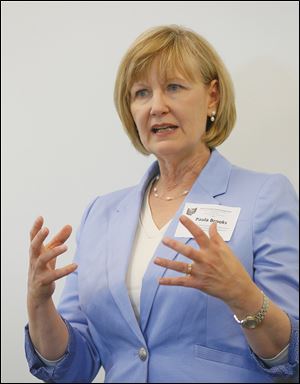
CLIMATE CHANGE
E. Toledo roundtable eyes perils of inaction
Speaker: Doing nothing could cost $150B a year
7/31/2014
Paula Brooks, a member of a White House state task force, speaks during Wednesday’s meeting at the Museum of the Great Lakes.
Political support for stronger greenhouse gas reductions will come as more Americans learn how doing nothing could cost the U.S. economy $150 billion a year, one of the featured speakers at an East Toledo event predicted Wednesday.
The estimate is part of a White House Council of Economic Advisers report issued Tuesday.
It was amplified Wednesday at the National Museum of the Great Lakes by Franklin County Commissioner Paula Brooks.
Ms. Brooks is one of 26 members — mostly mayors, county commissioners, or tribal leaders — of the White House State Task Force on Climate Preparedness and Resilience. The task force was assembled after a major climate-change speech President Obama delivered in June, 2013, marking the launch of his administration’s current initiative to have Congress step up efforts to reduce greenhouse gases.
The East Toledo event featured a 10-member roundtable discussion with an audience of 50 people representing a cross-section of business, labor, academic, and environmental interests.
Doing nothing will be far more devastating to the economy than reducing greenhouse gases, such as carbon dioxide, and conserving more energy, Ms. Brooks said.
Climate change drives up costs for public health, food production, water and air quality, national security, roads and sewers, and other issues.
The insurance industry and the military have been tracking climate change for anything from costs associated with crop losses to impacts of hurricanes, droughts, and greater frequency of major storms, Ms. Brooks said.
“These are becoming pocketbook issues,” she said.
Another speaker, Ashlee Grace, spokesman for Graham Sustainability Institute’s Great Lakes Adaptation Assessment for Cities at the University of Michigan, said the Toledo area now deals with 9 billion more gallons of precipitation a year than it did in the 1950s, mostly from stronger and more frequent thunderstorms. The additional rain is believed to be related to a 1.6-degree increase in northwest Ohio temperatures since the 1950s, she said.
“Those stronger storms — they are getting bigger and they are coming more frequently,” Ms. Grace said.
She cited a National Oceanic and Atmospheric Administration report which shows weather-related catastrophes on the rise nationally.
Dave Spangler, the 2014 Lake Erie Charter Boat Association captain of the year, said climate change drives up costs of treating the region’s drinking water and hurts the $11.5 billion tourism industry for Ohio’s eight Lake Erie shoreline communities.
The impact of land-based fertilizers such as phosphorus is exacerbated by heavy storms, he said.
Sarah Orlando, Ohio Clean Marinas coordinator, said the devastation caused by 2012’s Hurricane Sandy has inspired that program to work with Lake Erie marinas and other shoreline businesses on a climate change adaptation strategy.
Toledo could get more jobs and America could do more to address climate change if Ohio can “freeze the freeze” on the state’s renewable energy law, Ms. Brooks said.
That’s a reference to Senate Bill 310, the legislation which makes Ohio the first state to impose a two-year freeze on benchmarks it had in place for utilities to invest in renewable power. Gov. John Kasich signed the bill into law this summer. Opponents want to keep it from becoming permanent.
Contact Tom Henry at: thenry@theblade.com or 419-724-6079.